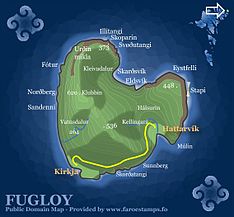Fugloy
You can help expand this article with text translated from the corresponding article in Danish. (January 2022) Click [show] for important translation instructions.
|
Fugloy
Fuglø ( UTC+1 (WEST) | |
|---|---|
| Calling code | 298 |
| Website | http://www.fugloy.fo/ |
Fugloy (pronounced [ˈfʊglɪ],
The name means bird island, and refers to the large number of birds that nest on the island's cliffs.
Geography
There are two settlements:
Fugloy is special because of the stone-material consisting of basalt stratum, making the island very steep and inaccessible. The Eystfelli cliffs, which are 448m are located on the east coast. Nearby on the 47-metre-high sea stack Stapin there is also a lighthouse, a natural arch feature and what looks like the outline of an Egyptian Pharaoh (the Pharaoh's Face).
Mountains
There are three mountains on Fugloy:
| Name | Height |
|---|---|
| Klubbin | 620 m |
| Norðberg | 549 m |
| Mikla | 420 m |
Flora and fauna
Important Bird Area
The island has been identified as an Important Bird Area by BirdLife International because of its significance as a breeding site for seabirds, especially Atlantic puffins (15,000 pairs), European storm petrels (25,000 pairs) and black guillemots (100 pairs), as well as for about 50 breeding pairs of Eurasian whimbrels.[1]
Fugloy was also a nesting site for the now extinct great auk (garefowl). On the east side of the island there is a rock ledge called Gorfuglarókin "Garefowl Ledge", and written sources confirm that great auks were still breeding on Fugloy in the 18th century.[2]
Mammals
Grey seals are regular visitors to the coastlines of Fugloy. Mountain hares were introduced by humans, and inhabit the higher altitudes on the island. Fugloy has its own subspecies of house mouse Mus musculus domesticus, as do some of the other Faroese islands.
Flora
In contrast to the other



History
The island has been populated since the
The smarter Sjúrður við Kellingará was forced to go the more militant way of rebellion by Høgni Nev and Hálvdan Ulvsson who were more criminally minded. All the four men were later caught and sentenced to death. Sjúrður við kellingar was shown mercy and amnesty, but the story goes that he could not live with the crimes that he and the others had committed under their "little" rebellion and asked to be executed with the other Floksmenn.
Because the
The Faroese parliament has tried to work out plans for the future of the island, such as the island getting electricity in the 1960s. In the 1980s a road from Kirkja to Hattarvík was built and a helicopter route to the island was established as well.
When the population was at its peak at the beginning of the 20th century, there were around 250-300 people living there. Due to a change in lifestyles and norms, island life has become less popular and people have moved away as a result. Today, there are only five people living all year around in Hattarvík and some 20 in Kirkja. There are few jobs on the islands; one shop and few jobs on the harbour are all that there are.
Másin the mail boat
Until taken out of service in 2010, the 1950s mail boat Másin was used as transit to Fugloy, making a popular attraction in itself. A newer boat is now used as a replacement but at Kirkja, passengers still have just a few minutes to jump ashore and get bags and their things with them. Oil for the electricity plant on Fugloy is transported in oil barrels and garbage is transported by the same boat and must be landed at the same time.
Tourism
The name Fugloy comes from the Faroese word fuglur for "bird" so it is not surprising that the island has a rich fauna of sea and land birds, especially puffins (Faroese: lundi) which inhabit the island in thousands. The view over to the nearest islands Svínoy and Borðoy is excellent, and sunsets that can be seen are among the things that make Fugloy feature in old pictures of the Faroe Islands.
Mythology
There are several myths connected to this island. In old Faroese Culture
- The Floating Island of Fugloy
It was said that Fugloy was once a floating island with
References
- ^ BirdLife International. (2012). Important Bird Areas factsheet: Fugloy. Downloaded from "Bird Areas Fact Sheet". Archived from the original on 2007-07-10. Retrieved 2013-08-30. on 2012-02-22.
- ^ J. Chr. Svabo, Indberetninger fra en Reise i Færøe 1781 og 1782; udgivet af N. Djurhuus. - Uforandret fotografisk genoptryk. - Kbh. : C.A. Reitzels Boghandel, 1976
External links
- personal website Archived 2006-10-05 at the Wayback Machine with 6 aerial photos of Fugloy

